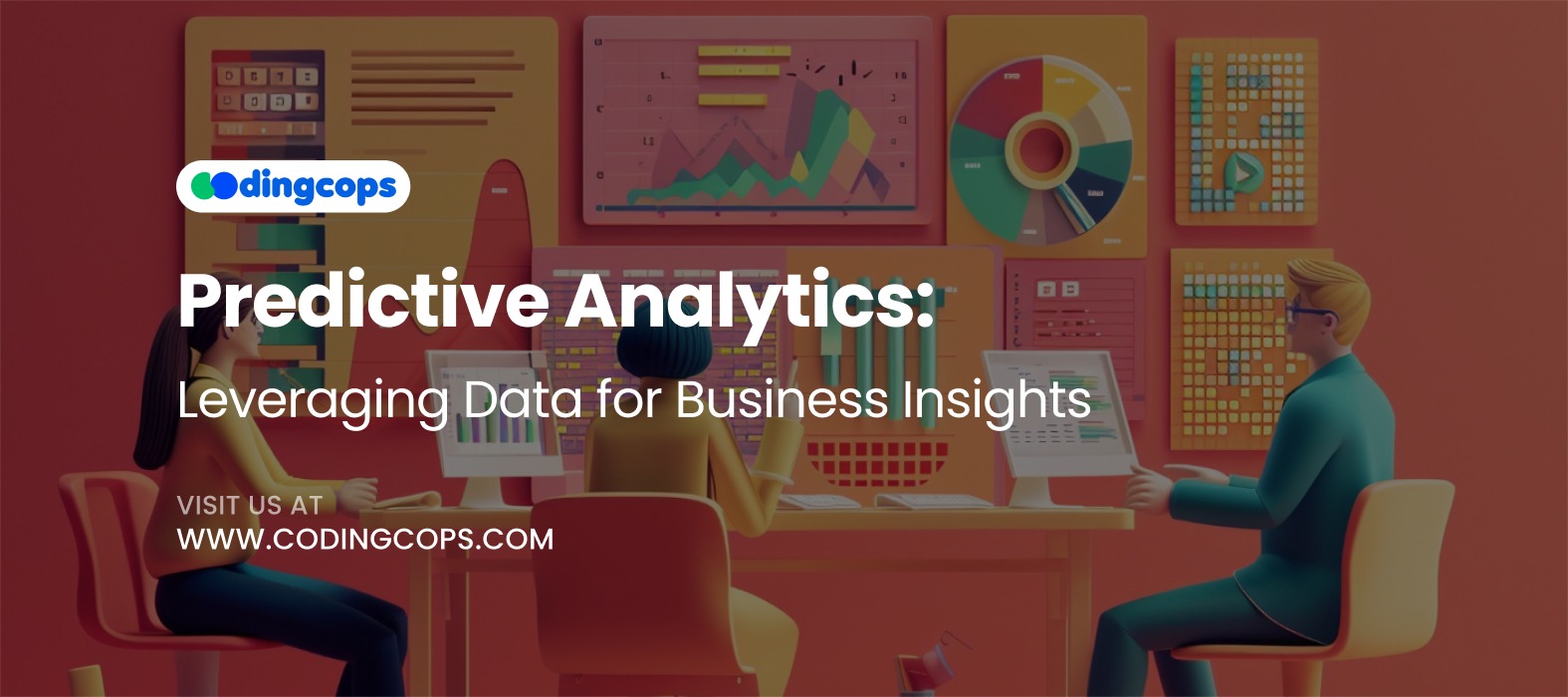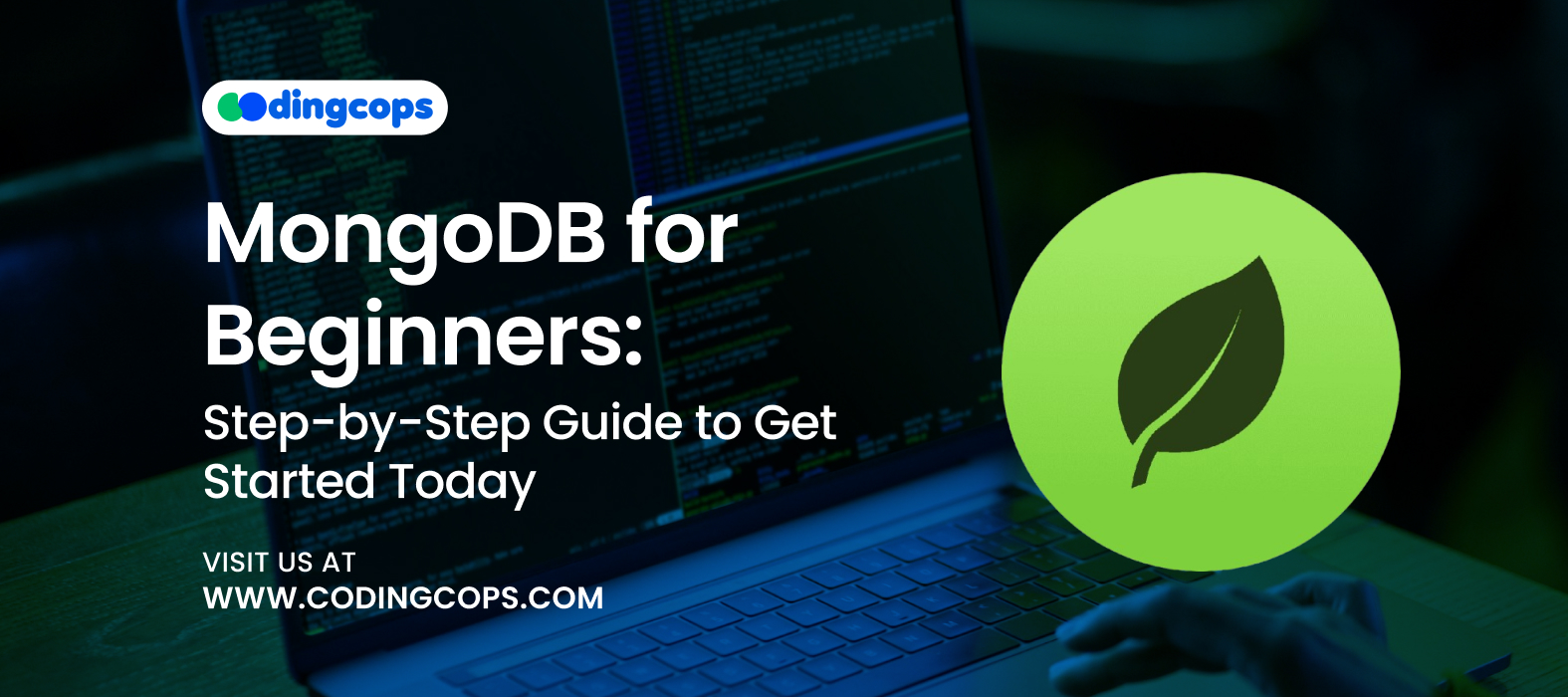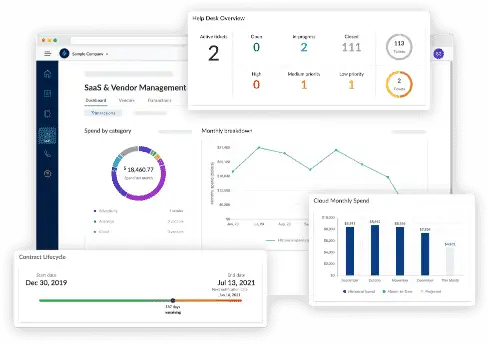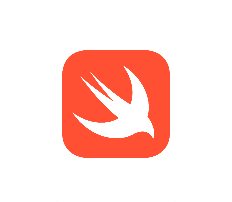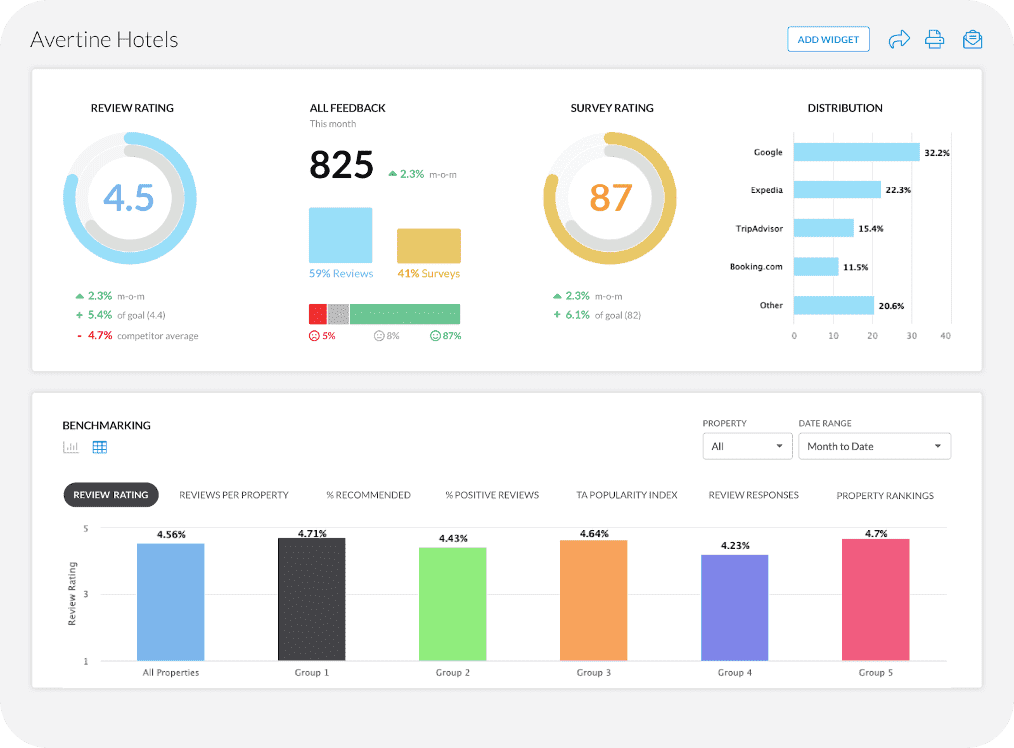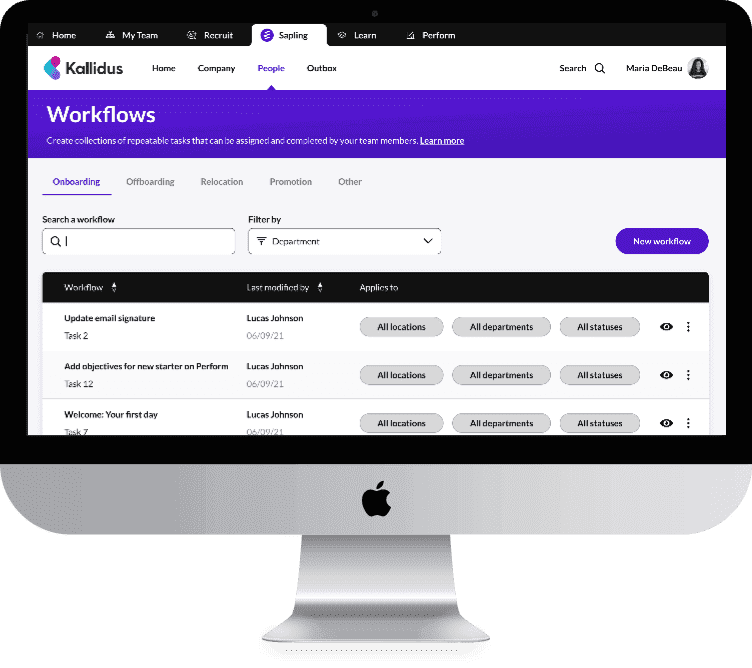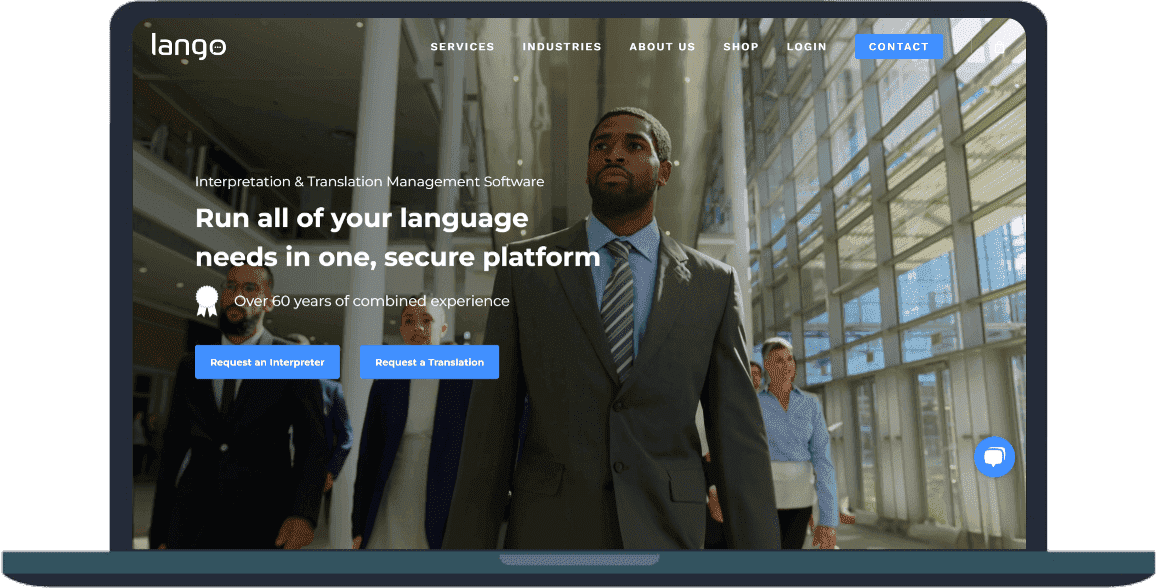FYI, in 2024, the Predictive Analytics market size was around $18.9B, which is expected to grow at a CAGR of 28.3% from 2025 to 2030. That’s astonishing!
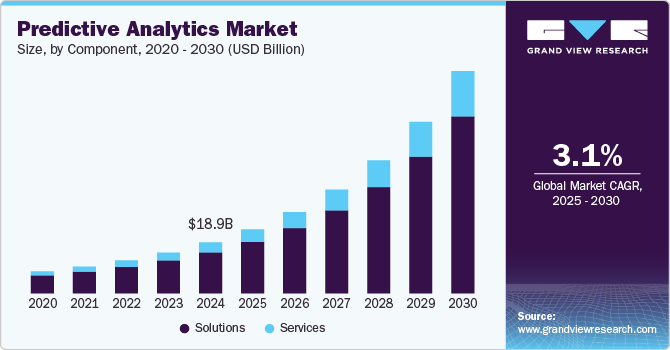
This is the thing that motivated us to inform you about predictive analytics and its role in helping businesses achieve new success heights.
We are in a data-driven world, where information is one of the most valuable assets a business can have. This has given rise to big data analytics, which helps businesses extract meaningful patterns from vast volumes of data.
Is data the sole player? If you think that by only having high quality or big data, you can achieve your goals, you are in the wrong place. Data can only be meaningful if coupled with predictive analytics.
So, to help you understand the role of predictive analytics in business growth, today’s article will enlighten you about the predictive analytics strategies, choosing the right technique, and challenges you may face along the way.
What is Predictive Analytics?
The process of analyzing historical data, statistical algorithms, and machine learning techniques to predict future results or outcomes is said to be Predictive Analytics. It has nothing to do with what has happened in the past or why it happened. It only focuses on forecasting the future.
Working of Predictive Analytics
Predictive analytics starts with the collection of data. You gather historical data and real-time data relevant to your project or problem. Once you have collected the data, you must do data analysis. Data mining, statistics, and machine learning are some of the different techniques used in analyzing your data. This assists you to learn and recognizing the patterns and trends of your data.
To continue, you must develop a predictive model using the discovered patterns and trends. This model assists you in making predictions regarding events and outcomes in the future. Lastly, the findings or predicted occurrences will enable you to be well-informed and take proactive steps.
Why Predictive Analytics is Important for Business Growth
In order to realize the importance of predictive analytics, we have to first come to the realization that the business environment in which we live today is dynamic. It faces fierce competition and has to handle massive data sets. At this point, only the historical reports or gut instincts won’t work. Rather, you need to be able to foresee trends and read customer demands and market changes. It is right at this moment where predictive analytics comes in.
By bringing in predictive analytics, you can:
- Foresee trends
- Prepare for future outcomes
- Effectively respond to market changes
After achieving this feat, you can:
- Drive customer engagement
- Improve products or services
- Identify potential business opportunities
- Enhance competitive advantage and business growth
Business Value of Predictive Analytics
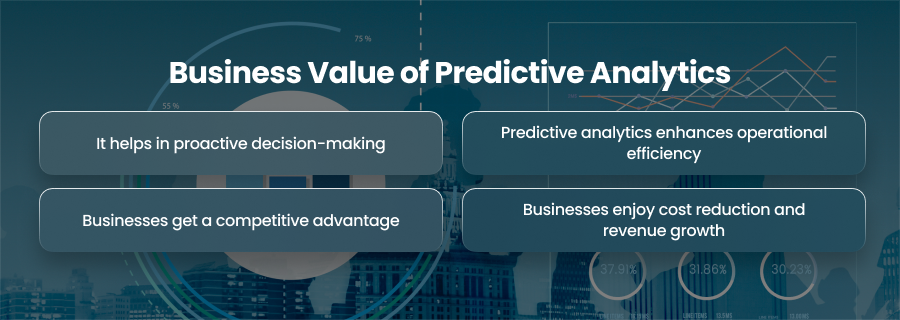
It helps in proactive decision-making
To begin with, predictive analytics assists companies in making proactive decisions as opposed to reactive decisions. Formulating proactive plans assists retailers in predicting demand to prevent situations of stockout, whereas marketers may employ predictive analytics to forecast the leads with the highest possibility of conversion.
Predictive analytics enhances operational efficiency
Second, when you begin to successfully predict things with predictive analytics, you will be able to optimize your business processes. In another example, predictive analytics is utilized by airlines to determine the best flight schedules. In contrast, the manufacturers can utilize it to schedule maintenance and minimize downtime.
Businesses get a competitive advantage
There’s no doubt that predictive analytics helps you anticipate market shifts or customer behavior before your competitors. But what’s the advantage of it? It gives your business a strategic edge as it helps you keep your business ahead of competitors and also uncovers risks at early stages. Moreover, it helps you detect fraudulent transactions.
Businesses enjoy cost reduction and revenue growth
Finally, your business will result in more intelligent decisions and investments through the aid of improved predictions. Companies drop off unwanted expenditure, improve marketing through campaigns, and cross-selling through reaching the right client at the right time.
Predictive Analytics Techniques
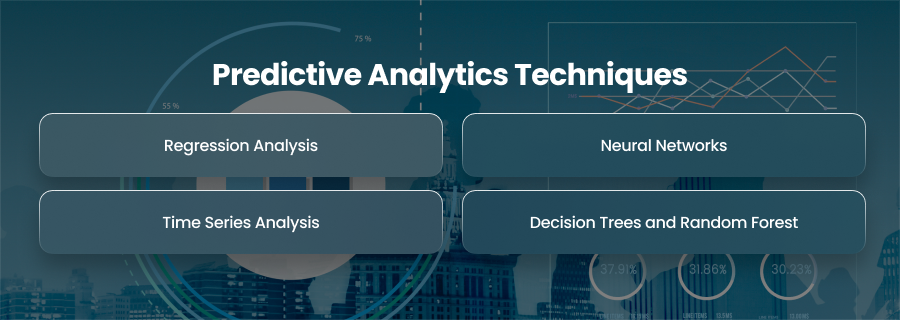
To begin with predictive analytics, you need to understand various techniques that can work for your business. Every technique comes with its unique features and perks that assist your business in grabbing more business.
Regression Analysis
A statistical method for simulating the relationship between independent and dependent variables is regression analysis. The approach helps to derive a relationship between the dependent variable and independent variable values as a regression line or curve to project the dependent variable values.
The most used regression is the linear regression where a direct line depicts the correlation of variables. It handles more complex forms of regression, such as multiple regression and polynomial regression.
How Regression Analysis Helps in Business Growth
Regression analysis assists in business growth by:
- Evaluating the efficiency of different media for advertising.
- Modeling the connection between sales income and advertising expenditures.
- Allowing companies to spend their marketing funds on the most efficient channels.
- Estimating how changes in the market will affect investment portfolios.
- Assisting companies in comprehending how asset prices and economic indicators are related.
- Defending the company against possible financial threats.
- Utilizing past sales data and outside variables to forecast product demand.
Neural Networks
A neural network is another model of predictive analytics that works like a human brain. It is inspired by the human brain structure. It is a powerful model that assists in pattern recognition and complex data analysis.
They have interconnected nodes known as neurons that learn from data by adjusting their connections, known as weights.
Role of Neural Networks in Business Growth
With neural networks, your business can:
- Automate the routine processes.
- Perform advanced data analysis.
- Enhance the customer service via chatbots and virtual assistants.
- Optimze marketing campaigns, predict customer behavior and identify potential leads.
- Identify and prevent cyberattacks.
- Enhance the decision-making process by identifying trends and patterns.
- Perform customer segmentation and personalization.
- Analyze historical data and predict future stock prices.
Time Series Analysis
Time Series Analysis is another technique of predictive analytics that helps in forecasting future values based on past observations. It identifies cyclical and seasonal variations.
Time series analysis works by analyzing data points collected at consistent intervals over time. This helps understand patterns, trends, and relationships.
Components analyzed in time series include:
- Trends
- Seasonality
- Cyclic patterns
How Time Series Analysis Works for Business Growth
Time series analysis works for your business by:
- Predicting future events based on historical data.
- Supporting strategic planning and better decision-making.
- Forecasting the sales trends.
- Managing supply chain operations.
- Forecasts stock prices, interest rates, and economic indicators.
- Predicting energy consumption patterns for utility companies.
- Enhancing efficiency in resource generation and distribution.
Decision Trees and Random Forest
Finally, there are decision trees and random forest methods of predictive analytics. A decision tree is a method used in machine learning that models a decision structure by nodes and branches.
The tree is many-branched, with the direction in each branching or node giving a decision based on the value of an attribute. It results in branches that depict the results of these decisions.
This process continues until a final decision or classification is reached at the leaf nodes. Moreover, decision trees are good for classification and regression tasks due to their high intuitiveness and ease of interpretation.
Conversely, random forest is an expansion of decision trees. It is an ensemble learning technique that constructs a number of decision trees and uses the output of these trees to enhance predictive accuracy and restrain overfitting.
How Decision Trees and Random Forests Help in Growing Businesses
With the help of decision trees and random forests, businesses can:
- Handle complex datasets.
- Divide customers on the basis of their purchasing behavior, preferences, and demographics.
- Make marketing strategies and personalize customer experiences.
- Reduce default risks and increase profitability.
- Identify patterns that deviate from normal transaction behavior.
- Perform predictive maintenance and reduce downtime.
Which Predictive Analytics Method to Choose
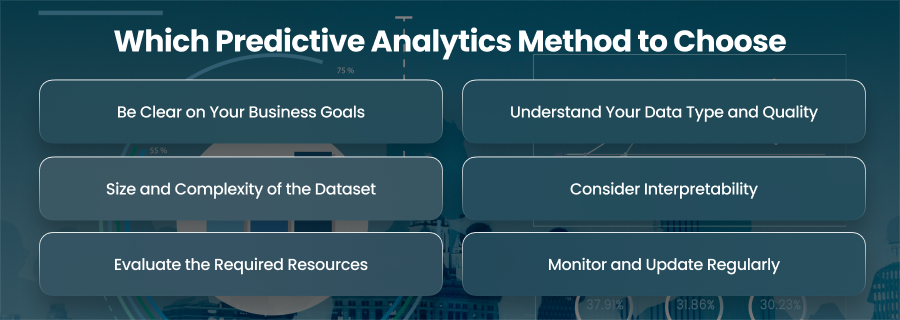
One way of ensuring that you get accurate and reliable insights is having the appropriate predictive analytics method in your business. This is to say that you ought to choose a method that suits your business objectives and the data collected, as well as the complexity of the prediction you are interested in making.
The following is a simple guide to choosing the most appropriate predictive analytics approach to your company:
Step 1: Be Clear on Your Business Goals
The first thing in any business is to know about the needs and wants. When you are clear about these two things, the coming steps are easier. In predictive analytics, you need to understand what sort of model your business seeks and how it wants to impact its customers. This careful analysis will help you choose the right predictive model for you.
Remember, choose a technique that aligns with your goals.
Step 2: Understand Your Data Type and Quality
Secondly, you need to analyze and understand your data. Here are the things to consider in this step:
- Look into your data; Is it structured or unstructured?
- Find out time-based trends in your data.
- Whether the data is clean or it requires preprocessing.
Step 3: Size and Complexity of the Dataset
The third step involves you to analyze the data size and its complexity. This will help you choose the right model for your data.
- If your dataset is small, you can choose decision trees or logistic regression for effective and interpretable results.
- For large and complex datasets, you should go with random forest or time series analysis.
Step 4: Consider Interpretability
Simpler models can work for you if your dataset is easy to understand and interpret. However, complex models will work for you if you want to capture more intricate patterns and your data is harder to interpret.
Step 5: Evaluate the Required Resources
Further, you need to look into the matter of resources required for working with predictive techniques. There are computationally demanding techniques that require high infrastructure and expertise, whereas simpler models can be easily implemented and do not need as much computation.
Therefore, to make the most of predictive analytics, the best course of action is to select a method that fits your technical capacities and your team skills as well as your time budget.
Step 6: Monitor and Update Regularly
The game isn’t over after choosing a technique. Even after selecting and deploying a model, you have to understand that the performance of the model degrades over time because of changes in the data patterns. This degradation in the model performance is known as model drift.
It commonly happens and can be handled by retraining your models with fresh data.
Industries Leveraging Predictive Analytics
Predictive analytics is everywhere. Down here, we are mentioning the industries that are widely using predictive analytics to elevate their business performance and take it to new heights.
- Retail and E-commerce
- Healthcare
- Finance and Banking
- Manufacturing
- Marketing and Advertising
- Telecommunication and Utilities
Challenges in Predictive Analytics
Along with a bunch of perks, there are some challenges that you might face while working with predictive analytics.
- You might face data-related issues such as incomplete or soiled data. Moreover, the data you gather can be inaccurate or outdated.
- Technical barriers can come your way in the form of model overfitting or underfitting. Further, you have to face the complexity of model interpretability.
- You can come to face organizational issues like your company doesn’t want to adopt a data-driven culture, or you can face a shortage of highly skilled data analysts or data professionals.
- Lastly, there can be ethical and privacy concerns as you have to ensure data privacy and compliance.
Future of Predictive Analytics in Driving Success for Businesses
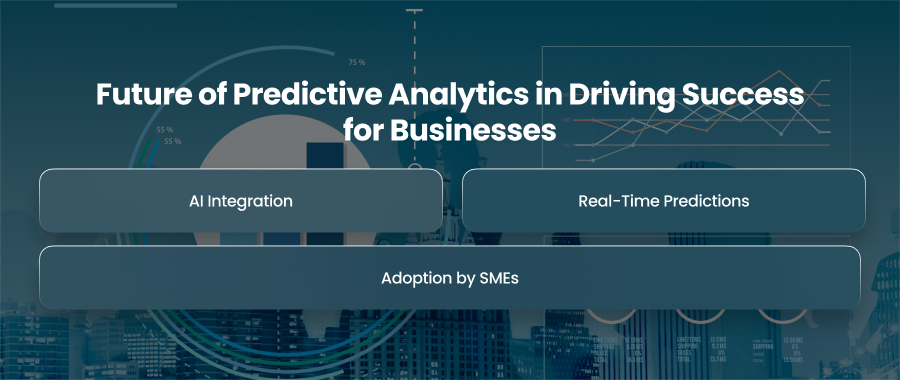
Soon, it is expected that predictive analytics will be driving success for businesses by:
AI Integration
In the future, Predictive analytics will rapidly integrate within AI ecosystems, promoting automated and intelligent decision-making.
Real-Time Predictions
When the data is available in real time, predictive analytics empower businesses to respond instantly.
Adoption by SMEs
Small and medium enterprises can utilize predictive analytics with a cloud-based service and affordable. This will enable them to get the most out of predictive analytics.
Ending Notes
So, predictive analytics can prove to be the game changer for all sorts of businesses. A small-scale business to a large enterprise can benefit from predictive analytics by incorporating it the right way. It gives you insights into future trends, market shifts, and customer behavior. Further, it enhances the decision-making capabilities that also take your business to new elevations. Hence, adopting predictive analytics will not only enhance your business but also give you ease of work.

